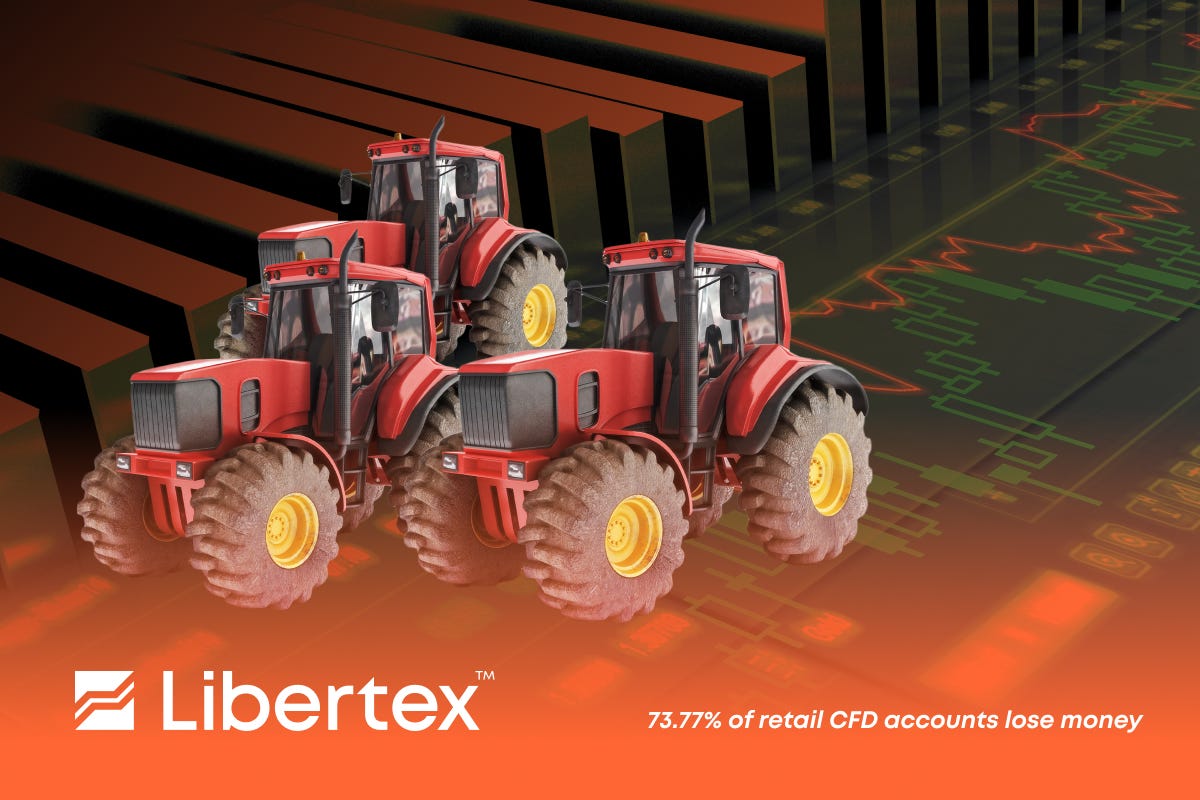Returning attention to raw materials as farmers protest | Posted by Libertex (Europe) | Coins | February 2024
Many of us thought that once the pandemic was over, everything would return to normal. Oh, how wrong we were! Since then, we have had to contend with hyperinflation, rising energy prices, geopolitical instability, international conflict, and more, with no end in sight to the drama. European farmers are once again up in arms, this time with recent protests closing several major capitals, including Brussels and Paris, and key border crossings across the Old Continent.
This is a long-standing crisis, but the biggest catalyst for recent action seems to be the EU’s so-called Green Deal, which will see subsidies cut, particularly for agricultural diesel. For farmers, this is a simple economic calculation. Costs are rising and expected to rise further, but agricultural prices are falling due to tariff exemptions on low-cost Ukrainian grain imports.
But the actions of agricultural producers appear to be reversing this trend. In the past month alone, wheat prices have risen 10%, breaking the key support level of $600 per bushel and are expected to jump further as protests continue. Considering that the May 2022 price is around $1200, there is ample room for further upside. And with oil prices rising simultaneously due to separate geopolitical factors, investors would be wise to consider overweighting agriculture and energy commodities in the coming months. In this article, we will look at some of the key drivers of price action in these markets, predicting where prices will head for the remainder of the year.
Despite making up just 4% of the European workforce, farmers are a vital cog in the machine and without them Europe would lack food security. This is becoming increasingly important as global tensions rise, and Brussels would do well to recognize this. There is a lot of buzz in political circles surrounding the European Net Zero Industrial Act (NZIA) and the Green Deal, but many farmers are concerned that the requirements are impractical and unlikely to come to fruition. Targets such as halving pesticides by 2023, reducing fertilizer use by 20%, using more land for non-agricultural purposes and doubling organic production to 25% of total EU farmland are all considered completely unrealistic by producers. It’s possible.
Moreover, annual subsidies of €55 billion, known as the Common Agricultural Policy (CAP), encouraged consolidation of farms and favored greater ownership. In fact, according to CAP, the number of farms in the EU has fallen by more than a third since 2005, leading to a concentration of large, low-leveraged land holdings that maximize production at low margins – a decidedly ungreen business model. Now that the NZIA has made it a legal obligation to adhere to these net zero targets, it is difficult to see how EU agricultural producers can survive without prices of key products such as wheat soaring. A stopgap solution that allows cheap imports from Ukraine and elsewhere is ultimately self-defeating and leaves Europe vulnerable in a conflict scenario.
As mentioned earlier, increasing hostilities and the threat of global war must bring food security issues to the forefront. But another important impact of global conflict is rising energy prices, which puts an additional straw on the camel’s back for farmers. Oil, electricity and gas have all risen sharply over the past few weeks. Brent crude and Light Sweet rose 10% and 9% respectively, while OPEC+ extended voluntary production cuts for another quarter. Henry Hub natural gas futures may be trending lower, but they are still well above pre-pandemic levels and safe and reliable supplies in Europe are still far from guaranteed. Diesel costs are now famously subsidized by European agricultural workers, but it is significant that many countries enjoy fuel prices that are around 30% of the European average price per liter.
With the European Union set to gradually withdraw subsidies for “dirty” fuels such as diesel, something will have to be done. In the absence of other factors, the only possible outcome is higher prices for agricultural products produced in the EU. Of course, this does not take into account the possibility that Brussels will continue to allow tariff-free sales of low-quality imports from third countries. But it will be a politically difficult question, given the environmental impact of production processes in those countries and the seemingly insignificant damage to EU-based producers. In this context, both wheat and oil prices appear to have reason to rise and remain elevated in the near term.
It also includes ETFs for cryptocurrencies, metals and commodities. Libertex allows you to open a variety of buy or sell CFD positions on agricultural products such as wheat, soybeans and corn, as well as energy resources such as Brent crude oil, WTI, Light Sweet crude oil and Henry Hub natural gas. To learn more or create your own account, visit www.libertex.com/signup today!

